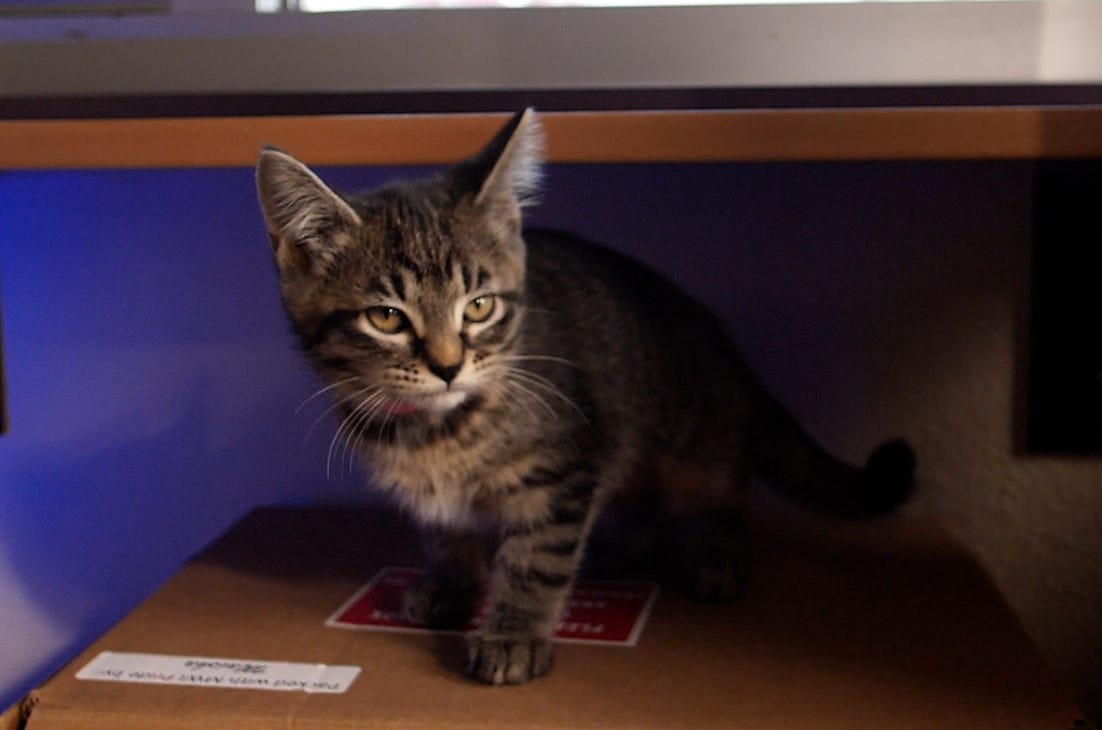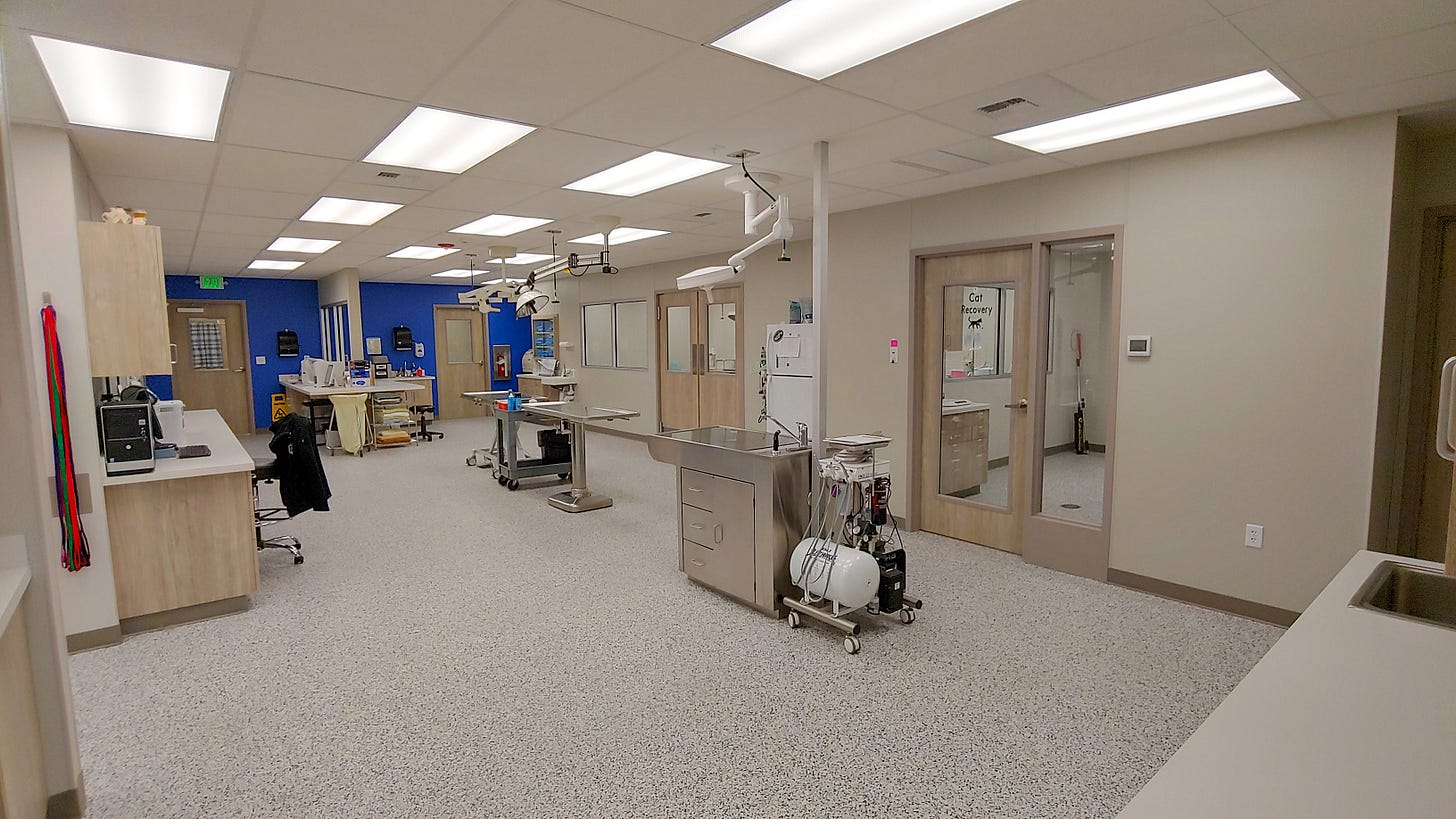Wenatchee Valley Humane Society Faces Criticism Over Community Cats Policy
Current volunteers and former employees express concern about new leadership, euthanasia decisions and the 'Trap-Neuter-Return' policy
The Wenatchee Valley Humane Society has been experiencing turbulent times since the first retirement of former Executive Director Dawn Davies in the summer of 2022. Davies came out of retirement to stabilize things after the tenure of her short-lived replacement, Taylor Sharp, before handing the reins off again to the current Executive Director James Pumphrey. Pumphrey has been at the helm since mid-December 2022.
That backstory will be explored in greater detail in the future, but it provides basic context to a situation former employees describe as a “downward spiral.”

Foster Coordinator Jasmine Broaddus quit Feb. 15 and Volunteer Coordinator Lauren Harlow quit Feb. 17. Shelter employee Rhiannon Gavin had previously put in her two week’s notice and her last day was Feb. 15 as well. Together they describe the workplace as “toxic” and Pumphrey as “condescending.”
Broaddus, who was promoted to foster coordinator under Davies and said she felt “targeted” by Pumphrey because she is assertive and asked questions. She said she feels like Pumphrey, whose last position was with the Animal Foundation of Las Vegas, doesn’t fully understand what it means to run a shelter in a rural community like the Wenatchee Valley.
“He has never worked in small shelters. He’s only ever worked in big city shelters, so I think he tried to take some of the big city shelter ways and bring that to our very small community shelter,” Broaddus said.
Pumphrey says it’s sour grapes from employees who didn’t like being held accountable by a new boss.
“With any growth comes change and with any change comes discomfort,” Pumphrey said. “We do reviews on staff, we have a progressive discipline policies – we put those standards in place and that doesn’t always feel comfortable to everyone.”
Harlow’s resignation was precipitated in part because of a lengthy Facebook post shared to local groups like “Notify Wenatchee“ in which an anonymous individual accused Pumphrey of various misdeeds and insinuated the WVHS is inappropriately euthanizing cats to make room for “kitten season.”
“He was the one who actually accused me of writing the Facebook post,” Harlow said. “Even though I wasn’t the one who wrote that post, because if I was it would have been way more accurate.”
The author criticized the shelter’s “Trap-Neuter-Return” and “Return-To-Home” policies, which are designed to reintroduce cats shelter administrators deem unlikely to be adopted or un-adoptable back to their outdoor homes. They’re also for friendly outdoor cats that likely have owners, but haven’t been fixed or microchipped. It’s an alternative to the “catch and kill” method of controlling cat populations, which the WVHS moved away from in 2018.
But according to the author of the Facebook post, adoptable cats are being put back out into the community because Pumphrey wants to keep the shelter clear.
It’s a concern shared by Chelan County resident Maurya Dunning, who described an incident in which she came upon an animal welfare officer dropping what she described as kittens off on Colockum Canyon Road in December.
“I pulled up and asked if he was OK. He said ‘yes’ so I went on my way. A few yards up the road I found a kitten, running down the middle of the road. There were high snowbanks on either side of the road for as far as you could see, and there was no way the kitten could get out. It had obviously just been fixed and had its ear tipped. There was still blood on the ear,” Dunning wrote in a message. “So I grabbed the kitten and went back to the officer and I asked him what was really going on.”
Ear tipping is a standard symbol for a cat that has been spayed or neutered and vaccinated. Dunning said the officer told her he was instructed to drop the cats off at that location and there was a cat colony in the area.
She asked him if she could take the cat and he said he couldn’t stop her.
“As I drove home, I realized this cat should be put up for adoption rather than dumped to be food for coyotes. I was in shock and I called the Humane Society to volunteer to take all further unwanted kittens,” she wrote. “They declined and said they had to return kittens to the same location in which they are trapped. I responded to say there is no way they were trapping kittens in the middle of nowhere, the location was not safe, gave them my address, and asked them to please dump kittens off at my farm and I would rehome them. The shelter is empty, and all of the cats I have are perfectly adoptable. Why are they turning people away? Why are they dumping kittens when there are plenty of people like me more than willing to take them?”
Dunning said she estimated the cat she took home that day was about four months old.
It’s not the first time he has come under fire for his advocacy of the TNR program. Animal welfare advocates in Las Vegas, where Pumphrey was previously employed, expressed concerns similar to Dunning’s and said the program needlessly places adoptable cats at risk.
But he said the TNR and RTH programs are science-driven and data-backed.
“We’re recognizing that all the compelling research is that the best possible outcome for them is to return them to where we found them,” he said. “They are 10 to 50 times more likely to get adopted from the field than from a shelter. They’re seven times more likely to return to their home if we put them back.”
He said people typically wait about two weeks before they start looking for their lost cats and applying the same method to dogs as cats isn’t supported by data that has been collected for more than two decades.
“We have to find a new pathway for cats, and that pathway is investing more and more in TNR,” he said.
He said it’s similar to how vaccines work. You need to get 70 to 80 percent of the population spayed and neutered in order to see a reduction in the overall population. Furthermore, removing a cat from a community can result in a vacuum in which other cats move in to fill the space left by the cat and can lead to an increase in breeding.
The WVHS follows the Million Cat Challenge guidelines. According to the Million Cat Challenge website, “Removal raises the risk of increased breeding or translocation of cats remaining in the community, thereby increasing risks to cats, public health and wildlife.”
Pumphrey said the WVHS serves an area that is approximately three hours in any direction and they couldn’t ever hope to shelter and adopt out all the community cats within that radius. These programs are the next best thing, he said.
Another piece of misinformation is that they lost funding to cover the cost of spaying and neutering, but that’s not true either, he said. They had a one-year grant to cover those costs and the year is up now, but they are reapplying for it. Until they get that funding back, the cost of a spay or neuter is $45.
He also said they haven’t lost any volunteers, which is another rumor.
“We have had no turnover in volunteers to be clear,” he said. “That was a complete fabrication.”
But volunteers who wish to remain anonymous say they have expressed concerns, and one even threatened to stop donating to the WVHS over the TNR policy.
But Pumphrey says that’s not the solution. He said the reason they have so few cats in the shelter right now is because they conducted a successful adoption campaign in December and January in which they focused on the getting the cats that had been at the shelter for 30 days or more adopted. He said they started with 76 cats and were “wildly successful” in getting most of them adopted.
He said before that campaign they were over capacity but now they have room and that’s a good thing.
“And yet those keyboard warriors make assumptions and started insinuating that something nefarious is going on rather than celebrating the success of a focused adoption marketing campaign,” he said.
He urged folks to be a part of the solution by not sharing misinformation and said unfortunately there will always be those who disagree with the policies of the humane society. However, those policies are backed by science and data that is available online. A good place to start learning about that is on Wenatchee Valley Humane Society’s website, where users can find a dashboard that provides statistics like shelter intakes, surgeries performed and adoptions to date.
“We want people to volunteer, we want people to foster, we want people to become regular donors,” he said. “That $5, $10 a month is huge for us. It’s super beneficial.”
He also said he is open and available to community members and volunteers who have questions, and wants the WVHS to have a reputation for its transparency.
If you’d like to learn more about the Wenatchee Valley Humane Society, reach out to Pumphrey or other members of the administrative team, learn about volunteering, fostering or becoming a donor, you can do that via the WVHS website here.
Looking Ahead
I will continue to follow this story as it develops and plan to go back and provide more of the backstory that may help explain the state of the organization that Pumphrey inherited. According to other former employees, Pumphrey took over an organization already in turmoil and deserves the chance to right the ship.
So in the coming weeks I will flesh out that part of the story by featuring the story of a former employee who left the organization because the individual who was originally supposed to be Davies’ replacement. We’ll also delve deeper into the subject of what a “low-kill” shelter means and the politics and ethics behind the “low-kill” vs “no-kill” debate.






I am so glad you picked up the mantel to report on this subject! SOOO much better than gossip! I know you will get the facts and that is terribly important!
TNR is currently the most humane solution to our overpopulation issue for cats who cannot be rehomed, are working, or are NOT in life threatening situations. This means feral cats who cannot be handled, community cats with jobs--such as rodent control at a shop, orchard, or winery. The quotes from Mr. Pumpfrey here are unclear about their full TNR policy, and it sounds like a sociable kittens were returned outside while shelter space was available. Not great! I would like to hear clarification about the org's TNR policy. Even if this cat was a candidate for "return" it goes back to its colony or trapping location, not the middle of the road. Returning a feral or community cat to their colony or place they were trapped in key for their own survival, moving ferals can be extremely challenging. And unfortunately, we have cat overpopulation issue everywhere, caused by humans. Unadoptable cats will have to go back outside, or be euthanized.
The valley really does not have consistent access to low-cost, high-volume spay and neuter services. It's so important to animal welfare. Getting funding through grants, vet shortage, etc. are all key factors in why it's hard to do. Spay and Neuter isn't the most marketable part of animal welfare, people forget about it, but it is beyond important.
TNR education and resources:
www.alleycatproject.org
www.Communitycatcoalitionwa.org
www.feralcatproject.org